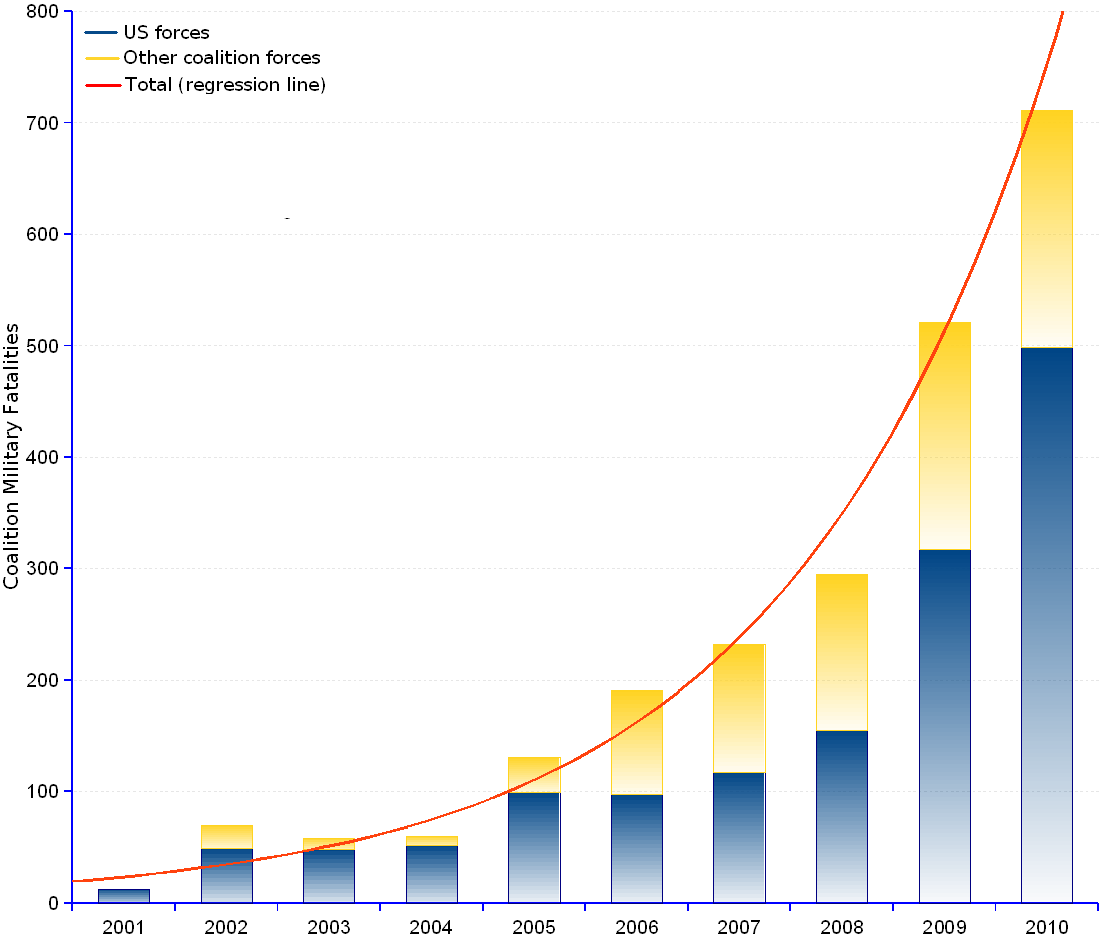

Every passing year the NATO adventure in Afghanistan claims higher flows of blood, resources and money only to drift farther away from its alleged mission objectives. In 2010 military fatalities numbered 711, a 36% increase on 2009, thus offering a convincing testimony of NATO's powerlessness to make the mark. Already 10-year long, the Afghanistan war ranks with the Vietnam war as the longest of all wars engaged by the USA, far exceeding World War I (2 years), World War II (6 years) or the Korean War (3 years).
From the duration standpoint, NATO's strategy (a) is not at fault, because it clearly stated that "there is no pre-defined end date for the mission" — although more than one high official may feel that it is becoming excessively long. However, NATO's expectations are at odds with reality when defined as a situation in which the Afghan National Security Forces are able to provide security and sustain stability without NATO/ISAF support. In fact, with or without NATO/ISAF support, no security, no stability, no peace, no justice, no decent living conditions, nothing but chaos, destruction and oppression is provided to the people of Afghanistan.
In spite of a significant swelling of the western forces to about 300,000 men, including US 100,000 military and 150,000 hired mercenaries, the Afghan fighters, far from being forced to flee or surrender, show enormous resilience and hit back with determination, thus feeding the worst fear (b) of western strategists: a steady attrition eroding public support and the will of ISAF member nations to continue fighting.
Other signs of a lost endeavor are patent in Afghanistan. US official reports alert to the chaotic situation that prevails in the military supply chain system, out-sourced to dubious contractors, that risks to put in jeopardy critical supplies to NATO forces in the field, while providing a significant source of funding for the Afghan fighters (c). US officials also uncovered evidence that the use of mercenaries results in funneling US dollars to Afghan warlords and strongmen linked to murder, kidnapping, bribery as well as Taliban and other anti-coalition parties (d).
A reliable indicator of the dead end where the NATO mission finds itself is the degree of deliquescence of the social values that make the fabric of a viable society. Corruption, abuse, treachery and extortion fueled by the ubiquity of powerful strangers handling vast amounts of US dollars destroy the remnants of justice, dignity, respect of personal integrity and trust-based relationships. Lack of progress in the field have led NATO leaders to copycat the infamous and ill-fated Phoenix operation (e) in Vietnam, setting up assassination teams and kidnapping squads (f) that operate in the middle of the night, or devising secret prisons where Afghans are taken for interrogation under torture (g) or outright assassination (h). Such excesses destroy the moral fiber of the western forces while alienating the local population — even stimulating its resolve to fight once it overcomes its fright.
For those who may ask whether NATO can still win the Afghanistan war, a sensible answer may be Kissinger's one (i). "In the traditional sense of fighting against an adversary with whom it is possible to make an enforceable agreement, no. In the sense of gradually defeating the insurgency and reducing it to impotence, theoretically yes, but it would take more time than the American political system would permit." In two letters : no.
Afghanistan War | |||
Year | USA | Other Coalition Members | Total |
| 2010 | 499 | 212 | 711 |
| 2009 | 317 | 204 | 521 |
| 2008 | 155 | 140 | 295 |
| 2007 | 117 | 115 | 232 |
| 2006 | 98 | 93 | 191 |
| 2005 | 99 | 32 | 131 |
| 2004 | 52 | 8 | 60 |
| 2003 | 48 | 10 | 58 |
| 2002 | 49 | 21 | 70 |
| 2001 | 12 | 0 | 12 |
| Total | 1,446 | 835 | 2,281 |
» Compare with the status at 31 December 2009 and at 30 June 2010
Sources: see Notes